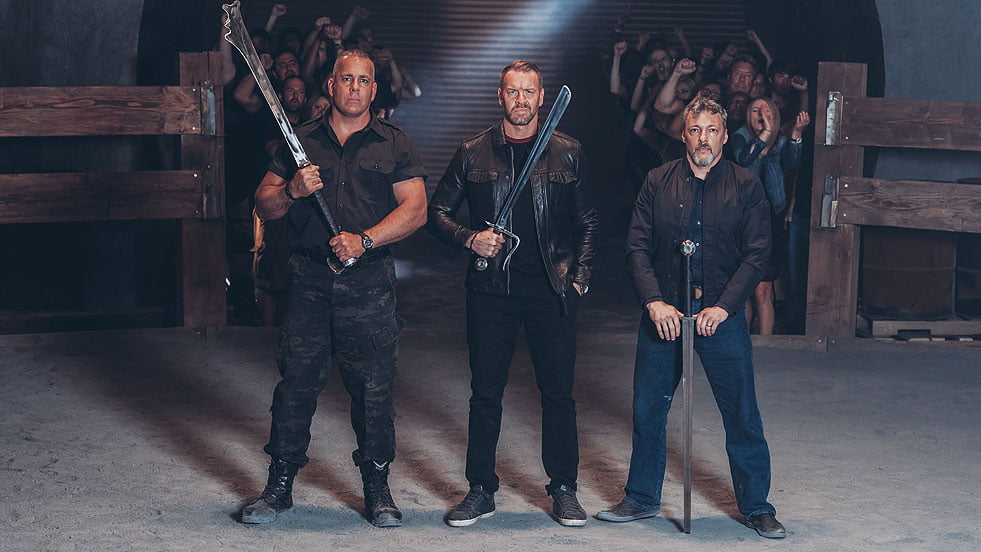This is Part 10 of The Public Medievalist’s special series: Gender, Sexism, and the Middle Ages, by Ken Mondschein. You can find the rest of the series here.
Knight Fight (History: Wednesdays, 10pm EST) is History’s new medieval-combat reality series, and its take on “muscular medievalism” (to use Amy S. Kaufman’s term) plays into our cultural stereotypes of the Middle Ages as a violent era exclusively populated by manly men whose primary aim in life was to uphold the patriarchy by beating one another with steel cudgels. Megan Arnott explored some of these stereotypes in her piece on advertising a few weeks ago. Like other pop-culture depictions of the Middle Ages, the judges, and the show’s promotional material in general, tirelessly insist on the hard-hitting, brutal nature of the fighting in the show. As one contestant intones in the trailer:
When I hit someone, I want them to suffer.
The producers have created a world in which men gather for the sole purpose of battling for dominance under the unforgiving eye of those who have already proven themselves. In this, it owes more to modern American high school and college sports culture, with its system of “cuts” and its elimination brackets, than to the medieval tournament, which was, to varying degrees, about training for battle, asserting social class, impressing the ladies, and winning pricey warhorses.
Knight Fight’s format is pretty simple: Six combatants take up blunted modern reproductions of medieval weapons, strap on medievalesque armor, and fight three “heats” (rounds) of a grand melee (a Hobbesian battle royale, that is, a “war of everyone against everyone”). After the first heat, the judges cull the initial six contestants down to four with the grim efficiency of high school football coaches. The final four form two teams who get dressed up in “iconic” armor based on that episode’s historical theme. Then the winning team kits up in whatever armor they please, are handed matched weapons, and fight a “duel” to determine a champion since, as the Highlander franchise taught us, there can be only one.
The rules are based on those developed for the annual “Battle of the Nations” international medievalesque fighting tournament (first held in Ukraine in 2009). The rules are simple: no hitting a man on the ground and no thrusting (or, “no pricks with weapons,” as one early translation from the Ukrainian rules had it). The judges decide who is in and who is out at the end of every round.

Knight Fight’s three judges are former professional wrestler Jay “Christian” Reso (there to add to add some star power from another “manly” fighting sport); retired Marine and experienced armored combatant Andre Sinou (who, along with Jaye Travis Brooks, Jr., is one of the chief American promoters of the sport of full-contact armored fighting); and John Clements (recruited for his expertise on medieval combat).

To be sure, the fighters who compete on Knight Fight deserve credit for their passion and hard work. Fighting full contact in armor is the most incredibly taxing anaerobic exercise I can think of. Most of the participants are excellent combat-sports athletes in fantastic physical condition. I’ve known men whose devotion to full-armored fighting led to real self-transformation from overweight, middle-aged pre-diabetics to lean, mean middle-aged fighting machines (as well as broken bones and concussions).
So, with so many talented people engaged in this Aristotelian pursuit of virtue, what’s wrong with it?
It’s this: the hit-’em-harder fighting style and hyper-aggressive soundbites from the competitors play neatly into popular ideas of Middle Ages as less civilized, more brutal, and amply provided with large manly men whose fighting style owed more to brawn than to brains.
This is an idea with a long history. The Victorians, for all their love of the Middle Ages, held some frankly bizarre ideas about medieval combat. Egerton Castle was an author, fencer, and one of the earliest proponents of reviving historical fencing techniques—but his ideas about early swordsmanship were dead wrong. As he wrote of chivalric fighting back in 1884, knights wore:
plate armour in battle, and, indeed, on most occasions out of doors… [which] …caused the sword to be regarded in the light of a weapon of offence only, sufficient reliance being placed on helmet and carapace for protection…. personal combat between two knights was determined, in a great measure, by the resistance of their armour and, ultimately, by their power of endurance.
Castle’s emphasis on “battering power” in medieval combat gave his Victorian age a convenient “other” against which they could measure themselves, coming out as more “civilized” than the Middle Ages. And this misconception of awkward, over-encumbered knights persisted. Films such as Lawrence Olivier’s 1944 film Henry V and the 1956 Danny Kaye vehicle The Court Jester, drawing their inspiration from A Connecticut Yankee in King Arthur’s Court, famously include scenes of knights having to be hoisted into their saddles by crane because their armor was so heavy. Nothing could be further from the truth.
In reality, medieval people really appreciated lightness and skill. You can see this in Gothic architecture, for example. While early Romanesque cathedrals were built with stocky pillars, thick walls, and small windows, as the Middle Ages went on, architects innovated time and again to make the pillars slimmer and slimmer (until they disappeared), the walls dizzyingly high (supported with flying buttresses), and the windows impossibly huge (seemingly supported only by a filigree of stone tracery). They were willing to risk catastrophic collapse in order to achieve lightness and demonstrate their skill.


Contrary to popular myth, a full suit of fourteenth-century armor usually weighed no more than 60 pounds (which is far less than what is carried into battle by modern soldiers). And far from a world in which knights clumsily clubbed at each other, medieval fighting was a martial art like any other, with skill winning the day more often than sheer endurance.
By contrast, the armor used in the show weighs about 80 pounds because it is made of thicker metal. However, it has to be that heavy in order to withstand the battering it gets—and to prevent the guys inside from being turned into so much chivalric pulp. The weapons are basically metal clubs—as I’ve discussed in an article dissecting Knight Fight’s historical accuracy for medievalists.net.
You would think that Knight Fight’s judges—at least those familiar with medieval combat—would do something to either correct this error or discuss the differences between this and medieval combat on the show. Unfortunately, John Clements doesn’t do much to correct this misconception. And why would he? His worldview is fully in harmony with Knight Fight.
The website for Clements’ organization, the Association for Renaissance Martial Arts (ARMA), has published articles defending the Crusades and taking swipes at Westerners who imitate Asian practices. Even while he maintains an ostensible martial multiculturalism in some essays, he muses on Western martial heritage. This shades into outright statements of European cultural superiority. The West has, to Clements,
produced the concepts of scientific inquiry, religious tolerance, individual liberty, economic freedom, and the rule of law, which have over centuries led to unsurpassed scientific discoveries, a monumental flowering of art and literature, and a standard of living unequaled in history…. Unlike those squalid suffering regions of the globe that did not embrace reason, science, and individual rights, the West achieved its unprecedented wealth, health, comfort, freedom, and personal opportunity as a direct result of its cultural values—not the blind chances of geography or climate.
What about academic ways of looking at the past, including approaches that make a virtue of diversity and representation of women? Sounding much like a heavily armed Jordan Peterson, he considers approaches that “avoid exploring our heritage” to be “an insulting waste” since:
martial arts are simply not subjects concerned a whit about gender, race, class, or sexual orientation—the post-modernist obsession nowadays of much of the politically-correct brand of Medieval and Renaissance studies.
His books take this further; as I once wrote in a review, they are:
infused with a liberal amount of screeds against modern sport fencers, theatrical fight choreographers, and anyone else the author deems lacking in proper martial spirit and intent.

In short, John Clements has spent a lot of time marketing the revival of historical European martial arts as necessary to combat an imagined degeneracy of the modern sport of fencing that matches the “postmodernist” threat to Western civilization as a whole. He’s taken Castle’s idea and turned it on its head by making a virtue of the very idea the Victorians condemned: Historical European martial arts are strong, manly, authentic, and good, while anything not matching this vision of the world is weak, inauthentic, degenerated, effeminate, and adulterated. This narrative is sort of the unspoken undercurrent of Knight Fight, and, indeed, of much of the modern historical martial-arts movement: If it’s not heavy and brutal, it’s no good.
This doesn’t mean that, despite Clements’ troubling attitudes (which the producers should have done their homework on), the show is necessarily an intentional “men’s rights” dog-whistle. The problem is that its aesthetic valorizes a vision in which competition between men is the only thing that matters. It is men who fight, who protect, who go into the world, take what is owed to them, and push forward Western cultural superiority. It is easy to understand why this fantasy of traditional gender roles might be appealing to certain people, but in a time when a commercial for razor blades can spark weeks of online debate about toxic masculinity, History needs to be more careful about what it presents.
While I think it’s terrific that my favorite hobby of medieval fighting is getting media attention, Knight Fight doesn’t do anything to challenge our pre-conceived notions about the Middle Ages as a primitive time filled with Conan the Barbarian knockoffs. Rather, History panders to the masses with a macho, brutal view of the Middle Ages. It’s long on manliness and short on context—and, in so doing, Knight Fight peddles a vision of the Middle Ages that The Public Medievalist has spent a lot of time and energy arguing against.
Full Disclosure: Both Paul Sturtevant and I tried out for the third judge slot, as did many other knowledgeable people.
If you enjoyed that article, please share it with your history-loving friends on Facebook, or on Twitter! And be sure to subscribe here to receive every new article from The Public Medievalist the moment it launches.




